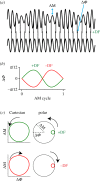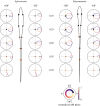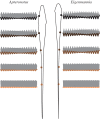The complexity of high-frequency electric fields degrades electrosensory inputs: implications for the jamming avoidance response in weakly electric fish
- PMID: 29367237
- PMCID: PMC5805966
- DOI: 10.1098/rsif.2017.0633
The complexity of high-frequency electric fields degrades electrosensory inputs: implications for the jamming avoidance response in weakly electric fish
Abstract
Sensory systems encode environmental information that is necessary for adaptive behavioural choices, and thus greatly influence the evolution of animal behaviour and the underlying neural circuits. Here, we evaluate how the quality of sensory information impacts the jamming avoidance response (JAR) in weakly electric fish. To sense their environment, these fish generate an oscillating electric field: the electric organ discharge (EOD). Nearby fish with similar EOD frequencies perform the JAR to increase the difference between their EOD frequencies, i.e. their difference frequency (DF). The fish determines the sign of the DF: when it has a lower frequency (DF > 0), EOD frequency is decreased and vice versa. We study the sensory basis of the JAR in two species: Apteronotus leptorhynchus have a high frequency (ca 1000 Hz), spatio-temporally heterogeneous electric field, whereas Eigenmannia sp. have a low frequency (ca 300 Hz), spatially uniform field. We show that the increased complexity of the Apteronotus field decreases the reliability of sensory cues used to determine the DF. Interestingly, Apteronotus responds to all JAR stimuli by increasing EOD frequency, having lost the neural pathway that produces JAR-related decreases in EOD frequency. Our results suggest that electric field complexity may have influenced the evolution of the JAR by degrading the related sensory information.
Keywords: Apteronotus; Eigenmannia; amplitude modulation; electrocommunication; signal interference.
© 2018 The Author(s).
Conflict of interest statement
We declare we have no competing interests
Figures








Similar articles
-
Chirping and asymmetric jamming avoidance responses in the electric fish Distocyclus conirostris.J Exp Biol. 2018 Sep 10;221(Pt 17):jeb178913. doi: 10.1242/jeb.178913. J Exp Biol. 2018. PMID: 30012575 Free PMC article.
-
Structure and function of neurons in the complex of the nucleus electrosensorius of Sternopygus and Eigenmannia: diencephalic substrates for the evolution of the jamming avoidance response.Brain Behav Evol. 2004;64(2):85-103. doi: 10.1159/000079118. Epub 2004 Jun 15. Brain Behav Evol. 2004. PMID: 15205544
-
Dynamics and stimulus-dependence of pacemaker control during behavioral modulations in the weakly electric fish, Apteronotus.J Comp Physiol A. 1987 Aug;161(2):175-85. doi: 10.1007/BF00615239. J Comp Physiol A. 1987. PMID: 3625571
-
Development of the jamming avoidance response and its morphological correlates in the gymnotiform electric fish, Eigenmannia.J Neurobiol. 1992 Dec;23(10):1446-66. doi: 10.1002/neu.480231007. J Neurobiol. 1992. PMID: 1487744 Review.
-
The neuroethology of electrocommunication: how signal background influences sensory encoding and behaviour in Apteronotus leptorhynchus.J Physiol Paris. 2013 Jan-Apr;107(1-2):13-25. doi: 10.1016/j.jphysparis.2012.07.001. Epub 2012 Sep 5. J Physiol Paris. 2013. PMID: 22981958 Review.
Cited by
-
Electrosensory Contrast Signals for Interacting Weakly Electric Fish.Front Integr Neurosci. 2019 Jul 31;13:36. doi: 10.3389/fnint.2019.00036. eCollection 2019. Front Integr Neurosci. 2019. PMID: 31417374 Free PMC article.
-
Modeling the Sequential Pattern Variability of the Electromotor Command System of Pulse Electric Fish.Front Neuroinform. 2022 Jun 28;16:912654. doi: 10.3389/fninf.2022.912654. eCollection 2022. Front Neuroinform. 2022. PMID: 35836729 Free PMC article.
-
A model for studying the energetics of sustained high frequency firing.PLoS One. 2018 Apr 30;13(4):e0196508. doi: 10.1371/journal.pone.0196508. eCollection 2018. PLoS One. 2018. PMID: 29708986 Free PMC article.
-
Chirping and asymmetric jamming avoidance responses in the electric fish Distocyclus conirostris.J Exp Biol. 2018 Sep 10;221(Pt 17):jeb178913. doi: 10.1242/jeb.178913. J Exp Biol. 2018. PMID: 30012575 Free PMC article.
References
-
- Moller P. 1995. Electric fishes: history and behavior. London, UK: Chapman & Hall.
-
- Lissmann HW. 1958. On the function and evolution of electric organs in fish. J. Exp. Biol. 35, 156–191.
-
- Bennett M. 1971. Electroreception. In Fish physiology (eds WS Hoar, DL Randall), pp. 493–574. New: York, NY: Academic Press.
-
- Heiligenberg W, Baker C, Matsubara J. 1978. The jamming avoidance response in Eigenmannia revisited: the structure of a neuronal democracy. J. Comp. Physiol. 127, 267–286. (10.1007/BF01350117) - DOI
-
- Heiligenberg W. 1991. Neural nets in electric fish. Cambridge, MA: MIT Press.
Publication types
MeSH terms
LinkOut - more resources
Full Text Sources
Other Literature Sources
Miscellaneous

